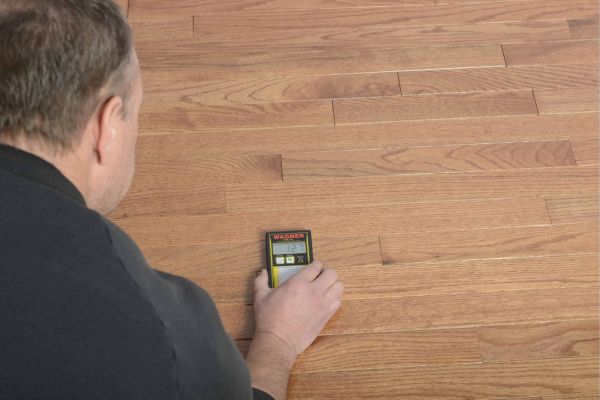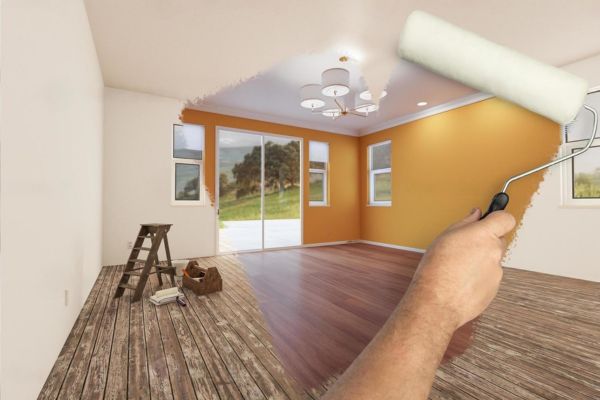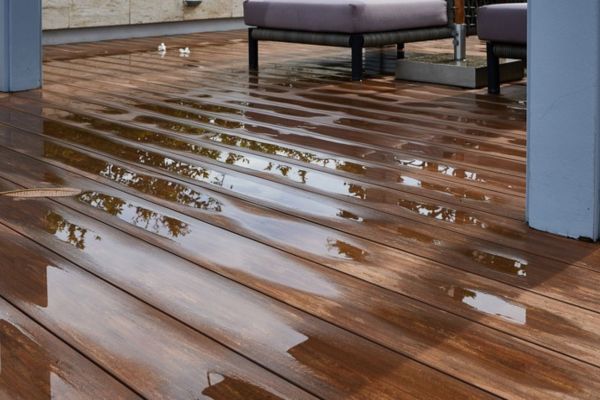Did you know that 40% of wood floor damage is caused by water? Whether it’s a spilled glass or a hidden leak, water can wreak havoc on your beautiful floors. If you’ve ever wondered, “Does water damage hardwood floors?” the answer is a resounding yes—and the effects can be costly if not addressed quickly.
In this guide, we’ll dive into:
- The science behind how water damages wood floors.
- Practical tips to prevent water damage.
- Step-by-step repair methods for minor and major damage.
- Long-term care strategies to keep your floors looking pristine.
How Water Damages Wood Floors: The Science Behind It
Does Water Damage Hardwood Floors? The Answer Lies in the Science
Water and wood are natural enemies, and understanding why starts with the science. Hardwood floors are porous, meaning they can absorb moisture. When water seeps into the wood, it disrupts the natural structure, leading to damage over time.
How Wood Absorbs Water
- Capillary Action: Water is drawn into the tiny pores of the wood, spreading deeper than the surface.
- Swelling and Warping: As the wood absorbs water, it expands. This can cause boards to warp, cup, or buckle.
- Mold and Mildew Growth: Prolonged exposure to moisture creates the perfect environment for mold and mildew, which can further damage the wood and pose health risks.
The Effects of Prolonged Exposure
- Discoloration: Water stains can leave dark spots or streaks on your floors.
- Structural Weakness: Over time, water can weaken the wood, making it more prone to cracking or breaking.
- Odor: Mold and mildew growth can lead to unpleasant, musty smells.
Visualizing the Damage
To help you understand the process, here’s a simple breakdown:
- Spill Occurs: Water sits on the surface of the wood.
- Absorption Begins: Water seeps into the wood fibers through capillary action.
- Damage Spreads: The wood swells, warps, or develops mold.
By knowing how water damages hardwood floors, you can take steps to prevent it—or address it quickly if it happens.
Types of Wood Floors and Their Vulnerability to Water Damage
Does Water Damage Hardwood Floors? It Depends on the Type
Not all wood floors are created equal when it comes to water resistance. Some types handle moisture better than others, while others are more prone to damage. Let’s break down the most common types of wood floors and their vulnerability to water damage.
Solid Hardwood Floors
- Description: Made from a single piece of wood, solid hardwood is classic and durable.
- Water Resistance: Low. Solid hardwood is highly susceptible to water damage because it absorbs moisture easily, leading to warping and swelling.
- Best For: Living rooms, bedrooms, and other low-moisture areas.
Engineered Wood Floors
“A study by the Forest Products Laboratory found that engineered wood floors are 50% more resistant to moisture than solid hardwood due to their layered construction” (Forest Service, 2024).
- Description: Made from multiple layers of wood with a top layer of hardwood, engineered wood is more stable than solid hardwood.
- Water Resistance: Moderate. While better than solid hardwood, engineered wood can still be damaged by standing water or prolonged exposure.
- Best For: Areas with moderate moisture, like dining rooms or home offices.
Laminate Floors
- Description: Made from composite wood with a photographic layer on top, laminate mimics the look of real wood.
- Water Resistance: Moderate to high. Laminate is more water-resistant than solid or engineered wood, but prolonged exposure can cause swelling at the seams.
- Best For: Kitchens, bathrooms, and other high-moisture areas (if labeled as water-resistant).
Bamboo Floors
- Description: Made from bamboo grass, this eco-friendly option is durable and stylish.
- Water Resistance: Moderate. Bamboo is more water-resistant than solid hardwood but can still warp or stain if exposed to moisture for too long.
- Best For: Living rooms, hallways, and other areas with occasional spills.
Water Resistance Comparison Table
| Floor Type | Water Resistance | Best For |
| Solid Hardwood | Low | Living rooms, bedrooms |
| Engineered Wood | Moderate | Dining rooms, home offices |
| Laminate | Moderate to High | Kitchens, bathrooms (if labeled) |
| Bamboo | Moderate | Living rooms, hallways |
Best Wood Floors for High-Moisture Areas
If you’re installing floors in areas prone to moisture (like bathrooms or kitchens), opt for:
- Water-Resistant Laminate: Look for products specifically labeled as water-resistant.
- Engineered Wood with a Waterproof Finish: Some engineered wood products come with added protection against moisture.
- Vinyl Plank Flooring (Bonus Option): While not wood, vinyl plank flooring is 100% waterproof and mimics the look of wood beautifully.
By choosing the right type of wood floor for your space, you can minimize the risk of water damage and keep your floors looking great for years to come.
Hidden Dangers: Long-Term Effects of Water Damage
Does Water Damage Hardwood Floors Over Time? Absolutely
Water damage doesn’t just ruin the appearance of your floors—it can also lead to serious hidden problems. Ignoring small spills or leaks can result in long-term damage that’s costly to repair and potentially harmful to your health.
Mold and Mildew Growth
- What Happens: When water seeps into wood floors, it creates a damp environment perfect for mold and mildew.
- Health Risks: Mold spores can cause respiratory issues, allergies, and other health problems, especially for children and those with weakened immune systems.
- Signs to Watch For: Musty odors, discoloration, or visible mold growth.
Structural Damage
- What Happens: Prolonged exposure to water weakens the wood, causing it to warp, buckle, or even rot.
- Long-Term Impact: Severe structural damage may require replacing entire sections of flooring or even subflooring.
- Costly Repairs: Structural repairs can cost thousands of dollars, depending on the extent of the damage.
Real-Life Example: A Costly Lesson
One homeowner ignored a small leak under their kitchen sink, thinking it wasn’t a big deal. Over time, the water seeped into their hardwood floors, causing:
- Warped boards that no longer lay flat.
- Mold growth that spread to the subfloor.
- A repair bill of over $5,000 to replace the damaged flooring and subfloor.
Don’t Ignore Small Spills or Leaks
- Act Quickly: Clean up spills immediately and address leaks as soon as you notice them.
- Monitor Humidity: Use a dehumidifier in high-moisture areas to prevent excess humidity from damaging your floors.
- Regular Inspections: Check for signs of water damage, especially in areas prone to spills or leaks (e.g., under sinks, near windows).
Long-Term Water Damage Effects at a Glance
| Effect | Description | Solution |
| Mold and Mildew | Causes health risks and unpleasant odors. | Clean spills immediately; use a dehumidifier. |
| Structural Damage | Weakens wood, leading to warping or rot. | Repair leaks promptly; replace damaged boards. |
| Costly Repairs | Can cost thousands to fix. | Prevent damage with regular maintenance. |
How to Test for Water Damage in Wood Floors
Does Water Damage Hardwood Floors? Here’s How to Check
If you suspect water damage, it’s important to act quickly. The sooner you identify the problem, the easier it will be to fix. Here’s a step-by-step guide to testing for water damage in your wood floors.
Step 1: Visual Inspections
- What to Look For:
- Discoloration (dark spots or streaks).
- Warping, cupping, or buckling.
- Mold or mildew growth.
- How to Do It:
- Examine the floor in natural light to spot subtle changes in color or texture.
- Check areas near windows, doors, and appliances where leaks are more likely.
Step 2: Use a Moisture Meter

- What It Is: A moisture meter is a tool that measures the moisture content in wood.
- How to Use It:
- Place the meter’s pins on the wood surface.
- A reading above 12% indicates excess moisture and potential damage.
- Compare readings in different areas to identify problem spots.
- Pro Tip: Moisture meters are affordable and available at most hardware stores.
Step 3: Check for Soft Spots or Buckling
- What to Look For:
- Soft spots that feel spongy when pressed.
- Boards that are raised or no longer lie flat.
- How to Do It:
- Walk across the floor and feel for uneven areas.
- Use a flashlight to check for gaps between boards.
Step 4: Inspect the Subfloor (If Possible)
- What to Look For:
- Water stains or warping on the subfloor.
- Mold or mildew growth.
- How to Do It:
- Remove a floor vent or baseboard to access the subfloor.
- Use a flashlight to inspect for signs of damage.
Step 5: Document Your Findings
- Take photos of any damage for insurance purposes.
- Write down the locations and severity of the damage.
What to Do If You Find Water Damage
- Minor Damage: Dry the area thoroughly and monitor for changes.
- Moderate Damage: Sand and refinish the affected area if possible.
- Severe Damage: Call a professional to assess and repair the damage.
Tools You’ll Need
- Moisture meter
- Flashlight
- Camera (to document damage)
- Dry cloth or towel
Preventing Water Damage: Pro Tips from Flooring Experts
How to Protect Wood Floors from Water: Expert Advice
Preventing water damage is far easier and cheaper than repairing it. With a few simple steps, you can keep your wood floors looking beautiful for years to come. Here are pro tips from flooring experts to help you protect your investment.
Use Area Rugs in High-Traffic Zones
- Why It Helps: Rugs absorb spills and reduce wear and tear on your floors.
- Where to Place Them:
- Entryways to catch dirt and moisture from shoes.
- In front of sinks, stoves, and refrigerators to catch spills.
- In hallways and living rooms to protect high-traffic areas.
- Pro Tip: Use rug pads to prevent slipping and allow airflow underneath.
Apply Waterproof Sealants
- Why It Helps: Sealants create a protective barrier that repels water and prevents absorption.
- How to Do It:
- Choose a high-quality, water-based polyurethane sealant.
- Apply 2–3 coats, allowing each coat to dry completely.
- Reapply every 2–3 years or as needed.
- Pro Tip: Test the sealant on a small, inconspicuous area first to ensure compatibility.
Maintain Optimal Humidity Levels
“To maintain optimal humidity levels, use a hygrometer to monitor indoor humidity and keep it between 30% and 50%” (EPA, 2024).
- Why It Helps: Wood expands and contracts with changes in humidity, which can lead to warping or gaps.
- Ideal Range: Keep indoor humidity between 30% and 50%.
- How to Maintain It:
- Use a dehumidifier in damp areas like basements.
- Use a humidifier in dry climates or during winter months.
- Monitor humidity levels with a hygrometer.
Clean Spills Immediately with the Right Tools
- Why It Helps: Quick action prevents water from seeping into the wood.
- What to Use:
- A soft, absorbent cloth or microfiber mop.
- A wood floor cleaner for sticky spills.
- What to Avoid:
- Steam mops, which can force moisture into the wood.
- Harsh chemicals that can damage the finish.
Repairing Water-Damaged Wood Floors: DIY vs. Professional
Cost to Repair Water-Damaged Wood Floors: What You Need to Know
If your wood floors have already suffered water damage, don’t panic. Depending on the severity, you may be able to repair them yourself or call in a professional. Here’s a detailed guide to help you decide.
DIY Repair Guide
Step 1: Dry the Area Thoroughly
- Use fans and dehumidifiers to remove moisture.
- Lift any wet rugs or furniture to allow airflow.
- Wait 24–48 hours to ensure the area is completely dry.
Step 2: Sand and Refinish Minor Damage
- Sand the damaged area with fine-grit sandpaper.
- Apply wood filler to any cracks or gaps.
- Refinish the area with a matching stain and sealant.
Step 3: Replace Severely Damaged Planks
- Remove the damaged planks using a circular saw or chisel.
- Cut new planks to size and install them with wood glue.
- Sand and refinish the new planks to match the surrounding floor.
When to Call a Professional

- Mold Growth: If you see or smell mold, call a professional immediately.
- Structural Damage: Warped or buckled floors may require subfloor repairs.
- Large Areas: If more than 10% of the floor is damaged, it’s best to hire a pro.
Cost Comparison Table
| Repair Type | DIY Cost | Professional Cost |
| Minor Sanding/Refinishing | 50–100 (materials) | 200–500 |
| Plank Replacement | 100–300 | 500–1,000 |
| Mold Remediation | Not recommended | 1,000–4,000 |
| Subfloor Repair | Not recommended | 2,000–5,000 |
If you’re unsure about the extent of the damage, consult a flooring professional for an assessment. It’s better to be safe than sorry!
Insurance and Water Damage: What You Need to Know
Does Insurance Cover Water-Damaged Wood Floors?
Homeowners’ insurance can help cover the cost of repairing water-damaged wood floors, but it depends on the cause of the damage and your policy’s terms. Here’s what you need to know.
What’s Typically Covered
- Sudden Accidents: Burst pipes, appliance leaks, or storm damage.
- Unforeseen Events: Water damage caused by a covered peril, like a fire suppression system.
What’s Typically Not Covered
- Neglect: Damage caused by failing to address leaks or spills.
- Flooding: Most policies require separate flood insurance for flood-related damage.
Tips for Filing a Claim
- Document the Damage: Take photos and videos of the affected area.
- Keep Receipts: Save receipts for repairs, cleaning, or temporary fixes.
- Understand Your Policy: Review your policy to know what’s covered and your deductible.
- Act Quickly: Report the damage to your insurance company as soon as possible.
Pro Tip
Consider adding a water damage endorsement to your policy for extra protection. It’s a small cost that can save you thousands in the long run.
FAQ Section
Does Water Damage Wood Floors? Your Questions Answered
Q: Does Water Damage Wood Floors Immediately?
A: Water can start damaging wood floors within hours if not cleaned up. Prolonged exposure leads to warping, swelling, and mold growth. Always clean up spills immediately to prevent long-term damage.
Q: Can You Fix Water-Damaged Wood Floors?
A: Yes, minor damage can be fixed by drying and refinishing the affected area. However, severe damage—such as warping, mold growth, or structural issues—may require professional repair or replacement.
Q: How Can I Prevent Water Damage to My Wood Floors?
A: To prevent water damage:
- Clean up spills immediately.
- Use area rugs in high-traffic zones.
- Apply waterproof sealants.
- Maintain humidity levels between 30% and 50%.
Q: Does Homeowners’ Insurance Cover Water-Damaged Wood Floors?
A: It depends on the cause of the damage. Most policies cover sudden accidents (e.g., burst pipes) but exclude damage caused by neglect or flooding. Always review your policy and document the damage thoroughly when filing a claim.
Q: How Do I Know If My Wood Floors Have Water Damage?
A: Look for signs like:
- Discoloration or dark spots.
- Warping, cupping, or buckling.
- Musty odors or visible mold growth.
- Soft spots or spongy areas when walking on the floor.
Water can cause significant damage to wood floors, but with the right knowledge and tools, you can prevent and address issues effectively. From using area rugs and sealants to maintaining humidity levels, prevention is key. For minor damage, DIY methods like drying and refinishing can work, but severe damage often requires professional help. If you’re dealing with water damage, don’t wait—reach out to the experts at Tri-State Ready Restoration. We specialize in repairing and restoring wood floors, ensuring your home looks its best. Contact us today for a free consultation.

